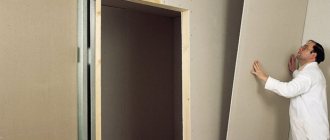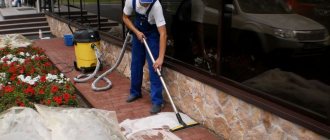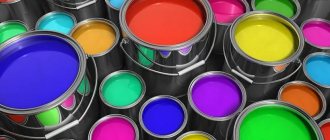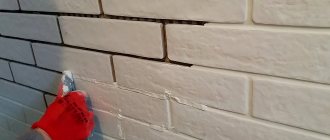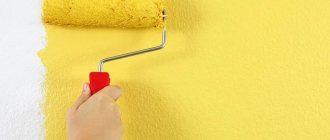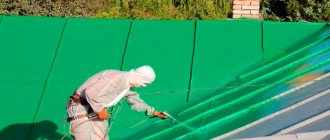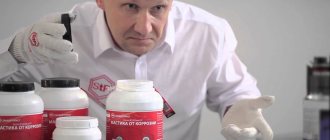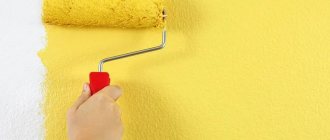The side curb stone is made of high grade concrete. High strength is its main quality. It is used to separate the part of the road where cars move from the pedestrian part, from public transport stops, from lawns, and for decorating flower beds. Borders not only fulfill their functional purpose, but are also used as a decorative element. Therefore, they are painted after installation. Border paint will enhance its durability.
Why are borders whitewashed?
Whitewashing borders is an essential element of landscaping. They are whitewashed for aesthetic reasons to create an atmosphere of celebration and comfort. Whitewashed curbs also help drivers navigate and distinguish the edges of the road in the dark or fog.
Interesting materials:
How to prune blackberries for the winter? How to prune and insulate roses for the winter? How should you prune red currants? How to prune remontant raspberries? How should roses be pruned for the winter? How should you prune roses for the winter? How should you prune roses in October? How should roses be pruned? How to prune roses correctly? How to prune currants in spring?
What paint is suitable for concrete?
Before painting the surface of the curbstone, you will first need to choose the right paint and color. Not all coloring compounds are suitable for processing such elements. The main requirement for concrete paint is breathability and water repellency. These properties are fully met by water-based facade painting compositions.
A coloring composition that is designed specifically for curbstones
This paint repels water and does not interfere with the “breathing” of concrete. You can also paint a street curb using polyurethane paint, which is available in a wide range of colors. Polyurethane paint compositions are resistant to abrasion and do not fade in the sun.
Advice! In order for the composition and color to last longer, before covering the curb stone with paint, dirt is carefully removed from its surface, cracks and chips are repaired, and a primer is applied.
Paints for paving slabs High-quality paint for paving slabs makes the surface more beautiful
Borders made of bricks Red brick is used for decoration, and the borders turn out beautiful.
To make the curbs attractive, you can use road paint; it is resistant to aggressive environmental influences and tolerates temperature changes well. The composition adheres easily to concrete and provides a beautiful, uniform color.
Many, wanting to save money for painting such elements, use ordinary lime, that is, they simply whitewash the borders. To obtain a different color, lime is diluted in water and a color is added there. This method is the cheapest, but short-lived. Whitewashed borders will have to be updated frequently.
Acrylic border paint is resistant to precipitation
Curbs look beautiful and cheerful if they are painted in bright colors; this method is used to improve the territory of preschool institutions. Often borders are painted in several colors at once, alternating them. Some people draw patterns on painted borders; this approach gives the elements a special appeal.
To paint the curbs, you can use stains and acrylic paints. The latter are better because such paint does not prevent the concrete from “breathing” and at the same time holds firmly.
The paint is designed specifically for curbs
In addition, acrylic paints are available in a wide selection of colors, which allows you to show your imagination. And to make the painted curb look more attractive, it is coated on top with a polyurethane paint composition; after it dries, a dense transparent film is formed, which creates additional protection.
The paint for the border stone can be any color, it all depends on your desire; if you want to make bright accents, take red or black. There are many options, you can combine and even mix colors (of the same type and manufacturer) in different ways, this will make the concrete more attractive.
This composition is an excellent choice for painting borders.
Painting tools and supplies
To paint a border with your own hands, you will need the following set of tools, accessories and consumables:
- The required volume of paint from the selected manufacturer with the required composition.
- Solvent or clean water, if necessary, to dilute the composition.
- Primer for exterior use, which increases the adhesive properties of paintwork.
- A container for mixing the components of a substance.
- Mechanical or electric mixer for mixing paint.
- Tray for convenient dosing of paint and varnish composition.
- A set of brushes or a roller for applying a substance to the surface to be treated.
- Paper, masking tape or film to protect adjacent coatings from paint.
- Paint scraper, knife and other tools for successfully removing old paint.
All specified tools must be in good working order, cleaned of dust and dirt, degreased and ready for use.
Safety precautions
Before painting work begins, special barriers are installed on the roadway.
Persons at least 18 years of age are invited to perform self-dying manually or mechanically. All workers employed at the site must undergo a medical examination, training course, and instruction (both general and in the workplace). Knowledge of safety rules is also tested with registration in the safety register. Workers must be provided with personal protective equipment for their hands, special shoes, clothing, safety glasses and respirators . There should be a first aid kit with medications at the work site. If paint compositions come into contact with the skin, they are removed with a napkin or cotton wool, after which they are washed with soap and water.
In accordance with SNiP 12.03.99 “Labor safety in construction”, the following must be observed:
Difficulties of the process
When doing the work of painting the border with their own hands, beginners often make gross mistakes that affect the result.
- Applying paint to an old coating or over a dirty curb. In such situations, rapid delamination of the substance is possible due to uneven adhesion.
- Incorrect mixing of paint and varnish composition with solvent or water - adding foreign liquids should be done only in accordance with the instructions for the substance.
- Painting side stones in rainy weather - paints and varnishes are destroyed if applied in a humid environment before polymerization.
- After the first season, the coating must be restored. You should purchase paints only from trusted manufacturers who have a quality certificate for their products. Painting should be carried out only in the warm season, at above-zero temperatures, to improve performance properties.
Before painting products, it is recommended to familiarize yourself with the master classes of professionals and listen to the recommendations of experts. In such cases, the finished coating will serve no less than the period stated by the manufacturer.
conclusions
Studying photos is a harmless activity where you will begin to realize your idea of creating a colored rock garden in your garden. The material is very flexible, sometimes heavy, of course. Therefore, we advise you to prepare it first and the more, the better (see also the article “Paint for concrete: which one to choose”).
Research what kind of material you have and carry out some systematization by size and shape; this stage will already be able to clarify a lot with the result. The paints themselves, oddly enough, will not cause problems. They, of course, are the “chiefs” of the entire process, but “they will appear at the last moment.”
Until then, you will have enough time to watch our additional video in this article more than once.
Source of the article: https://nashaotdelka.ru/vneshnjaja/dizain/1674-kak-pokrasit-kamni
Coloring option
In bulk
It is considered the most practical and best way. In this case, coloring pigments in powder form, which are used for concrete, are added directly to the gypsum solution. Thus, you receive a product that is painted from the inside.
When cutting or chipping, you will not see the white base.
Painting artificial gypsum stone with coloring pigments
A beige or yellow solution is best, and in polyurethane form, parts of the stones can be painted with liquid pigments using a brush.
- take ½ tsp. color (pigment);
- add 200 ml of water;
- add 200 ml of any acrylic primer.
When the stone has set, remove it from the mold and dry it, and after laying it on the surface, apply a matte water-based varnish to it.
This option for painting decorative gypsum stone is the most effective and almost all manufacturers use it. That’s why we can see these kinds of products in stores. The disadvantage of this method is the rough and unnatural painting, which can be observed at close range.
By making gypsum artificial stone yourself, you have the opportunity to work on naturalness by carefully painting parts of the stones in the mold. Of course, no one will do this on an industrial scale, otherwise the price will increase significantly.
Below we will propose another painting technology that will help make a product from gypsum tiles that is more similar to natural stone. You will learn how to paint artificial stone so that it has the same natural veining and color scheme as natural stone.
Surface
- tinting paste for water-based paints (color pigment);
- water;
- spray or brush.
Tinting paint for artificial stone
The instructions are simple - you need:
- add a coloring pigment to the water, you can even add several at once;
- dip a brush into the solution;
- saturate gypsum tiles with it.
Artificial gypsum stone has unique properties of developing shades that are similar to natural ones due to the absorption of tinted water.
Tip: add 30-50% of the weight of any acrylic-based primer to water to give additional strength to the product after drying.
In order to give gypsum stone the desired shade and color, you do not need to have an artistic education. Dip the brush into the colored water and paint the stone as you see fit.
In the photo - paints for working with plaster
Then you can tint some with a dark solution consisting of color pigment and water. You shouldn’t think too much about the palette, since each gypsum tile, even with the same texture, will absorb the solution differently, which will allow you to create an individual pattern each time.
Advice: using fire-retardant metal paints Polistil in your apartment or house, you can protect the items you need from fire.
- spray gun;
- sprayer for glass cleaning products.
Pour paint diluted with water-based tinting paste into a container and spray it onto the gypsum tiles. How to putty a ceiling with your own hands video for a beginner before painting? It is better to use several of these sprayers with different colors in your work so that you can treat different places on the stone.
Then the painting process will be better and faster.
The advantage of painting yourself
- The store offers artificial stone in standard colors and with obvious artificial coloring. It does not have natural colored veins, like natural ones.
- You can purchase products in white or plain beige, glue them to the walls, and then paint them on the spot with water and coloring pigments diluted in it. This method makes masonry much more natural. (See also the article Types of finishes: options.)
Interior paint for application to plaster
- Once the plaster stone has dried and become faded and pale in appearance, open it with any silky matte or matte varnish. This way you can restore the color saturation of the product, strengthen and protect its surface.
Tip: use water-based varnishes; they have no toxic odor and dry faster.
- If you want to achieve a “wet” effect on artificial stone, use glossy varnishes for painting, but be aware that this will slightly reduce the naturalness of the material.
Average prices for work
On the Internet, many construction companies and individuals offer services for painting road or garden borders. Considering the high level of competition in the market, average prices for this type of work are approximately the same :
- Road curbs – from 150 rub./p. m. (1 layer), from 250 rub./p. m. (2 layers).
- Main side stones (up to 600 mm high) – from 400 – 600 rubles/p. m.
- Garden borders – from 100 rub./p. m.
- Improvement of park areas using multi-colored compounds - from 200 rubles/p. m.
- Identification of signal zones in places of increased danger, according to GOST - from 300 rubles/p. m.
The above prices may vary slightly depending on the volume of work, number of layers, seasonality, weather, remoteness of the site and internal company policy.
Benefits of coloring
- Possibility of changing color every few years;
- Unlike pigmentation of concrete mortar, surface painting of a concrete path allows you to obtain a coating of the desired color with a more saturated palette and density;
- The coating protects the concrete from the penetration of water into the pores, thereby extending the service life of the garden sidewalk;
- Application can be done manually in a short time, and walking on the concrete surface is allowed immediately after the paint has dried - from several hours to a day;
- The path can be washed with water; dirt, as a rule, does not eat into the coating formed by the paint layer.
Step-by-step instruction
Painting the curb is a simple job that does not require professional help. To achieve the expected result, you must follow the technological map :
First of all, you need to monitor the weather forecast so that there is no rain on the selected day.- The old coating is completely removed from the curb stone.
- The surface to be treated is cleaned with a high-pressure washer and brushes, and then thoroughly dried.
- The adjacent surface - the road surface, sidewalk or lawn - is protected with film.
- A primer is applied to the curb.
- Wait 30 - 40 minutes until the composition is completely polymerized.
- The paint is mixed in the required proportion with the solvent.
- The substance is poured into the dosing tray
- A brush or roller is dipped in paint and then evenly distributed over the surface of the curbstone.
- After the first layer has dried, the operation is repeated.
- Upon completion of the work, it is necessary to inspect each painted border and paint over individual areas with a small correction brush.
After applying the paint, it is recommended to wait until its final polymerization for at least 12 - 24 hours, after which the side stone can be used in normal mode.
Making a flower bed made of cement
You can decorate a concrete flowerbed by using small pebbles, paint, mosaics, and stencil designs. Here everything will depend on imagination and creativity.
How to paint a concrete flowerbed in the yard
The simplest option for decorating a cement flower garden is painting. For work, compositions intended for concrete surfaces and stone are suitable. The painting process is not complicated:
- Treat the surface from dust.
- Apply two layers of deep penetration primer.
- Paint the flowerbed in the chosen color.
How to make a flowerbed from concrete and fabric with your own hands
Flowerbeds made of concrete, burlap and fabric fit original into the existing landscape design. As for the auxiliary materials, you will need a suitable container such as a plastic bucket; it will serve as the form of a flower bed. The step-by-step process of making a flower bed from a towel and cement is as follows:
- Make a concrete solution of liquid consistency.
- Place the rag into the concrete mass and hold it for a few minutes until it is completely saturated. Hang it on a bucket, which is first recommended to be lubricated with mining or any oil.
- After 48 hours, when the cement is completely dry, the flowerpot should be removed from the bucket and painted in bright colors.
A flowerbed made of cement and rags will have a more interesting appearance if the edges are slightly curved outward.
Drawing and mosaic
You can make a flowerbed out of concrete of any shape - round, square, or diamond-shaped. It is good to use mosaic elements to decorate it. Flower beds decorated with shells, sea pebbles, and fragments of ceramic tiles look very impressive.
First you need to decide on a pattern, then draw its contours on the concrete surface with chalk. Using glue and decorative elements, fill the interior space of the pattern. Upon completion of work, varnish.
Garden decorations
You can improve the area with the help of artificial trees made of sculptural concrete. These decorative hollow products can be represented not only by full-fledged plantings, but also by their individual parts. Stumps, branches, and roots made of cement look beautiful in the garden.
Negative consequences of whitewashing
The consequence of insufficient gas exchange is a lack of nutrients in the root system, which leads to its gradual weakening, rot, and ultimately the root collapses into dust.
A massive tree can no longer hold on to such a weak foundation and falls, dragging with it asphalt or paving slabs turned out by the remains of roots.
News about trees falling on citizens or cars is just an illustration of what improper whitewashing in the city leads to. Naturally, the question arises - why are they still doing this?
Secondly, in the 20th century this process was actually justified - during World War II, white tree trunks served as night landmarks for drivers driving with their headlights off to avoid detection by enemies.
In peacetime, this is absolutely useless, moreover, it harms green spaces. People of the older generation have formed the belief that white trees and borders decorate the city and make it brighter and more comfortable.
For housing and communal services workers, this is also an additional item for reporting on the work done.
However, it would be much more effective to revise outdated schemes and direct funds to real improvement of urban infrastructure - road repairs, improvement of children's and sports grounds, parking lots, landscaping, etc.
What you need to know about paving slabs
Painting curbs is one of the most common types of road work.
For optimal results, special paints and varnishes should be used. Painting the border in bright colors allows you to solve a whole range of problems. First of all, this operation allows you to effectively differentiate between the roadway and the sidewalk. At the same time, they can better see the dividing line at any time of the day and in difficult weather conditions. Thus, painting curbs significantly increases road safety.
Concrete products, rather than granite stone, are increasingly being used as a delimiter. Their installation is justified from an economic point of view, but they do not have durability.
How to make slaked lime at home?
Step-by-step instructions for slaking lime at home
:
Use clean tap water in a 1:1 ratio. Water is poured into the container in small portions. When boiling stops, the solution must be stirred. At the end of the reaction, the mixture is stirred until smooth.
Interesting materials:
Where did Instasamka live? Where does Khlestakov live? Where does Conor McGregor live in Moscow? Where do Azerbaijanis live in Georgia? Where do homeless people live in winter? Where do the notes live? Where is the pound sign on the keyboard? How to quickly and well prepare a retelling? How will Chatsky find out who started gossip about him? How to read faster and remember better?
What's it like abroad?
There are many examples showing that whitewashing is the fate of the post-Soviet space. Let's remember:
- the famous Central Park in New York;
- the beautiful Champs Elysees in Paris;
- gardens of Kyoto and Okinawa, full of cherry blossoms.
In none of the listed places are trees whitewashed, and at the same time they look aesthetically pleasing, natural and beautiful. There are thousands of similar examples around the world.
But what about pest control?
To prevent bark beetles from causing any harm to plantings, chemical solutions are used in civilized countries. They are colorless and non-toxic, making them safe for green spaces.
If the damage from parasites is too great, then tree trunks are wrapped with special materials, reliably protecting them and without damaging the structure.
Trees are painted in Africa
This practice exists, but it is the exception rather than the rule. This tradition is observed only in certain tribes, which mark the boundaries of the village in this way.
The important thing is that Africans prepare a painting solution from natural materials that do not harm trees in any way, and it acquires a bluish-blue tint
Impregnation primers, primers
They come on an organic and inorganic basis. Since these are impregnations, they do not form any film on the surface, and therefore cannot peel off or come off. Their components penetrate into concrete and bind molecules with polymer chains. As a result, the strength of the surface becomes 2-3 times stronger, resistance to aggressive environments (acidic and alkaline), temperature changes increases, it tolerates frost better, and the formation of dust is also eliminated.
In general, there are three types of primers for concrete:
- Polyurethane. Their main purpose is waterproofing; they are also used to make repair mortar: the primer is mixed with sand and cracks and chips are repaired with this mixture.
- Water-dispersed. They do a good job of dust removal and slightly strengthen the concrete surface. Their prices are average.
- Epoxy. For the most part, they are two-component, prepared before application, and their main purpose is waterproofing.
After two layers of concrete impregnation, the floor does not generate dust at all
If, after treating with a primer, you will not paint the floor or fill it with any other finishing coating, then water-dispersion primers are best suited for dust removal of garage floors. For paint or other coatings, primers of the same type are used: for polyurethane paint for concrete of the same composition, preparation is used, etc.
Polyurethane (polymer) impregnation for concrete
This garage coating is good for everyone, except for the price - 1 liter costs about $5. You can find packaging of 3 kg and 20 kg. Impregnation consumption when applying the first layer is 0.25-0.5 kg/m2. For the second - 0.15-0.2 kg/m2.
When processing, do not dilute, smear generously, at least twice. Polyurethane impregnation for concrete binds particles without forming a film. Such a concrete floor will stop generating dust and will absorb less liquid. The same compounds are used to strengthen crumbling concrete surfaces. If the process has already gone far, they will not help, but if only traces of abrasion are visible, impregnation will help delay the process.
Application of polyurethane impregnation
Polymer impregnations are applied only to dry surfaces. The moisture content of the concrete should be no more than 5% (at least 28 days must pass from the moment of pouring). The composition is poured onto the floor in portions, spreading with a roller or a special mop over the entire surface. Some companies can add color, so you can get a colored garage floor at the same time. This treatment can be used as a preparation for the subsequent application of paint or polymer floor covering.
Application features: temperature should be from 0°C to 17°C, air humidity not lower than 70%. If the humidity is lower, it must be moistened artificially - with electric humidifiers or by hanging wet rags in the garage, constantly making sure that they do not dry out. Only under such conditions will polymerization be good.
Epoxy primers
This type of impregnation consists of two components that are mixed immediately before use. You can work with them at temperatures above +5°C, there are no other requirements. The cost is higher than polymer ones - $7 per kg, consumption is almost the same.

